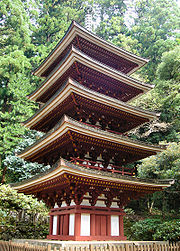
Murō-ji
Encyclopedia

Shingon Buddhism
is one of the mainstream major schools of Japanese Buddhism and one of the few surviving Esoteric Buddhist lineages that started in the 3rd to 4th century CE that originally spread from India to China through traveling monks such as Vajrabodhi and Amoghavajra...
, located in the city of Uda
Uda, Nara
is a city located in northeastern Nara, Japan.On January 1, 2006, the towns of Haibara, Ōuda and Utano, and the village of Murō, all from Uda District, were merged to form Uda City. As of December 29, 2005 the population was 38,648 people. The total area is 247.62 km².Each former town became a ward...
, Nara
Nara Prefecture
is a prefecture in the Kansai region on Honshū Island, Japan. The capital is the city of Nara.-History:The present-day Nara Prefecture was created in 1887, making it independent of Osaka Prefecture....
, Japan
Japan
Japan is an island nation in East Asia. Located in the Pacific Ocean, it lies to the east of the Sea of Japan, China, North Korea, South Korea and Russia, stretching from the Sea of Okhotsk in the north to the East China Sea and Taiwan in the south...
.
Murō-ji shows its typical aspect of Shingon Buddhism, with its buildings laid on the mountainside of .
Unlike many temples of the time, Murō-ji was opened to females. For that reason, the temple is also called Mount Kōya for women.
Overview
While legend has it that the temple was opened by En no GyōjaEn no Gyoja
En no Gyōja , or En no Ozunu , born 634, was a Japanese ascetic and mystic, traditionally held to be the founder of Shugendō, a syncretic religion incorporating aspects of Taoism, Shinto, esoteric Buddhism and traditional Japanese shamanism...
by order of Emperor Temmu
Emperor Temmu
was the 40th emperor of Japan, according to the traditional order of succession.Temmu's reign lasted from 672 until his death in 686.-Traditional narrative:...
, later restored by Kūkai
Kukai
Kūkai , also known posthumously as , 774–835, was a Japanese monk, civil servant, scholar, poet, and artist, founder of the Shingon or "True Word" school of Buddhism. Shingon followers usually refer to him by the honorific titles of and ....
, an extant record kept by the temple, , tells that a successful ritual in respect of a ryūjin
Ryujin
, also known as Ōwatatsumi, was the tutelary deity of the sea in Japanese mythology. This Japanese dragon symbolized the power of the ocean, had a large mouth, and was able to transform into a human shape. Ryūjin lived in Ryūgū-jō, his palace under the sea built out of red and white coral, from...
to cure Prince Yamabe's (later to become Emperor Kammu
Emperor Kammu
was the 50th emperor of Japan, according to the traditional order of succession. Kammu reigned from 781 to 806.-Traditional narrative:Kammu's personal name was . He was the eldest son of Prince Shirakabe , and was born prior to Shirakabe's ascension to the throne...
made the imperial court order a monk of Kōfuku-ji
Kofuku-ji
is a Buddhist temple in the city of Nara, Nara Prefecture, Japan. The temple is the national headquarters of the Hossō school and is one of the eight Historic Monuments of Ancient Nara inscribed on the UNESCO World Heritage List.-History:...
named to construct a temple on the site. The construction of the temple was taken over by a pupil monk , after Kenkyō's death in 793.
Among the buildings that remain from the ninth century is the five-storied pagoda, which is the smallest of the kind standing in the open air. The pagoda suffered major damage in a 1998 typhoon, when a falling tree struck it. It was restored over the following two years.
In Edo period
Edo period
The , or , is a division of Japanese history which was ruled by the shoguns of the Tokugawa family, running from 1603 to 1868. The political entity of this period was the Tokugawa shogunate....
, the temple buildings were repaired by donation of Keishō-in, mother of Tokugawa Tsunayoshi
Tokugawa Tsunayoshi
was the fifth shogun of the Tokugawa dynasty of Japan. He was the younger brother of Tokugawa Ietsuna, thus making him the son of Tokugawa Iemitsu, the grandson of Tokugawa Hidetada, and the great-grandson of Tokugawa Ieyasu....
.
About a kilometer east of the temple is located Ryūketsu Shrine, enshrining the ryūjin.
See also
- Zennyo RyūōZennyo Ryuois a rain-god dragon in Japanese mythology. According to Japanese Buddhist tradition, the priest Kūkai made Zennyo Ryūō appear in 824 CE during a famous rainmaking contest at the Kyoto Imperial Palace.-Name:...
- List of National Treasures of Japan (temples)
- List of National Treasures of Japan (paintings)
- List of National Treasures of Japan (sculptures)
- For an explanation of terms concerning Japanese Buddhism, Japanese Buddhist art, and Japanese Buddhist temple architecture, see the Glossary of Japanese BuddhismGlossary of Japanese BuddhismThis is the glossary of Japanese Buddhism, including major terms the casual reader might find useful in understanding articles on the subject. Words followed by an asterisk are illustrated by an image in one of the photo galleries...
.

